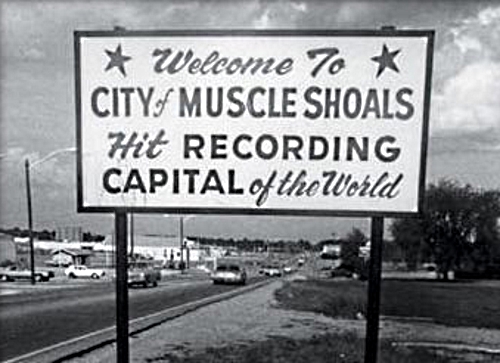“Working at Muscle Shoals was by far the best period for me, from the middle sixties through the seventies. I think my understanding was broadened and deepened so much by watching records being made from scratch, rather than deductively from written arrangements. Oh, man, it changed my life! There was never such an interaction between me and the musicians, and there was never anything like it in New York or LA.” — Jerry Wexler, quoted in Richard Buskin’s Inside Tracks
The whole Muscle Shoals phenomenon easily ranks as one of the most fascinating-and perhaps downright unbelievable-stories in the history of pop music recording.
How did this sleepy, small-town backwater on the Tennessee River become hotbed of soul music hit-making in the sixties, and then in the seventies a recording Mecca for a dazzling roster of rock superstars including The Rolling Stones, Bob Dylan, Paul Simon, Traffic, Rod Stewart, Bob Seger, Lynyrd Skynyrd and others?
It defies credibility. Muscle Shoals certainly lacked great hotels, fine restaurants, fast-paced night-life (make that any night-life), or miles of sun-drenched tropical beaches. No, instead Muscle Shoals’ sole drawing card to rock’s elite was a peculiar musical culture that somehow bred musicians gifted with funky chops, steely determination, an open musical mind, and a rare commodity called 100 proof Alabama honky soul.
I made two pilgrimages to Muscle Shoals, one in October of 1979 and again in January of 1980. The first trip resulted in a Mix article entitled “The Strange But True Muscle Shoals Story,” published in the December issue. The second trip was for a followup story, tentatively slated for M.I. magazine, that was never published.
What follows is the guts of that second story, with some additions, deletions and updates.
With the first string of R&B hits, nobody really knew where they came from. They emerged incognito from this unknown corner of Alabama, spread to the cities of the south, soon were picked up and promoted nationwide, with some crossing over onto the pop charts.
The first wave launched Arthur Alexander, Jimmy Hughes, Joe Tex and white teeny-popper Tommy Roe. The records sold in the millions, but only a few insiders knew of the source.
But hit records have a way of attracting industry attention. Soon some well-connected outsiders started making the rural Alabama pilgrimage.
First over the Tennessee line was Jerry Wexler of Atlantic, moving down from Memphis following a spat with Jim Stewart of Stax. In tow, he brought Aretha and Wilson Pickett.
Within months, this isolated community on the back porch of Dixie was challenging Detroit and Memphis as the R&B capital of the planet. Percy Sledge. James and Bobby Purify. Arthur Conley. The music of black America was moving into the mainstream, yet few realized that the musicians propelling the tracks were white.
Following the assassination of Martin Luther King, the situation became increasingly complicated-and trends in black music had changed as well.
Though the R&B heyday hit a social roadblack, the now-legendary ex-casket factory on Jackson Highway soon became a magnet for a who’s-who of rock superstars. Paul Simon. Boz Scaggs.
Joe Cocker. Lynyrd Skynyrd. The Rolling Stones. Leon Russell. Traffic. Bob Dylan. The studio and its musicans received some notoriety as rock journalists made the pilgrimage alongside the artists.
The fog of mystery lifted and the Muscle Shoals story became fully documented.
The “Secret” Sessions
Well, not quite. A few curious tidbits of information have yet to escape the Tennessee River swamplands.
For example, did you know that Boz Scaggs, before cutting his classic Atlantic solo debut (featuring Duane Allman on slide) came to Muscle Shoals posing as a reporter for The Rolling Stone?
Also little known: Before hooking up with Keith Godchaux, ex-Grateful Dead vocalist Donna Godchaux (nee Thatcher) worked as a secretary and sometime backup vocalist at Muscle Shoals Sound Studios.
Most Jimmy Cliff fans would assume “Sitting in Limbo” from The Harder They Come soundtrack was recorded in Kingston. Nope. Like other “secret” Shoals sessions, it was never officially credited on liner notes because Cliff was not properly papered to “work” (i.e. record) while visiting the USA.
These and other revelations emerged from hours of conversation with the Muscle Shoals Rhythm Section: Barry Beckett, Jimmy Johnson, Roger Hawkins and David Hood.
Although these four played on the vast majority of Muscle Shoals hits from 1967 through 1980, they were actually the second generation of hit-record pickers. It all began nearly five years before, with Rick Hall and Fame Studios.
Hall started the original Fame in a couple of small rooms over a downtown drugstore. In 1961, he discovered a singing bellhop in a local hotel, and brought him into the makeshift studio with a rhythm section culled from a local band called Dan Penn and the Pallbearers, and cut “You’d Better Move On.”
It was a minor hit the following year. But momentum built slowly, as he cut more hits with Jimmy Hughes and Tommy Roe before the original rhythm section—bassist Norbert Putnam, keyboardist David Briggs and drummer Jerry Carrigan-were lured away by more lucrative session rates in Nashville.




















